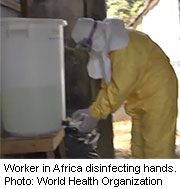
THURSDAY, Feb. 19, 2015 (HealthDay News) — The cough of very sick Ebola patients could be as dangerous as their vomit or diarrhea to those around them, a new report suggests.
However, the same experts also cautioned that this does not mean that the deadly virus could spread quickly through the air, as illnesses like measles or flu do.
The report “shouldn’t be something that alarms the public into believing that Ebola could become airborne in the way that measles is,” said Dr. Amesh Adalja, a senior associate at the University of Pittsburgh Medical Center’s Center for Health Security.
“This paper doesn’t say that,” said Adalja, who was not involved in the study.
According to the study authors, the saliva of an Ebola patient does contain traces of the virus. Also, the amount of virus in bodily fluids such as blood, saliva, vomit and diarrhea increases as they grow more ill, noted the report from the University of Minnesota Center for Infectious Disease Research and Policy.
Ebola attacks nearly all the body’s organs, including the lungs. So, if a caregiver breathes in droplets coughed by an Ebola patient, “it is possible that primary pulmonary infections could occur,” the Minnesota team wrote.
Based on prior evidence, health workers dealing with Ebola primarily have worried about disease transmission from a patient’s blood, vomit and feces, all of which contain high levels of virus as symptoms progress, the study authors noted.
But health care workers also might need to worry about a patient’s cough, the authors speculate in the Feb. 19 issue of mBio.
“The West Africa Ebola epidemic surprised even the most astute infectious disease experts in the global public health community,” the report concluded. “We should not assume that Ebola viruses are not capable of surprising us again at some point in the future.”
Still, they stressed that airborne transmission of Ebola — similar to that which occurs with the flu or measles — remains unlikely in the future, given that it would require the virus to undergo a substantial mutation.
The West African epidemic has so far caused 9,380 deaths out of more than 23,250 likely cases, according to the U.S. Centers for Disease Control and Prevention.
The United States has had two imported cases of Ebola, with infected people entering the country from abroad and then falling ill. While treating one of those patients, two Dallas nurses also became infected with Ebola. Experts have not been able to determine how the nurses were infected. One potential source was their patient’s bodily fluids.
Adalja said the new report “makes some good points about Ebola and what we know.”
“We know that about a third of Ebola patients cough,” said Adalja, who is also a spokesman for the Infectious Diseases Society of America. The paper’s authors “raise the question of whether Ebola could be spread by cough.”
But he said that the likelihood of airborne transmission being a common occurrence remains very low.
The report authors cited a well-known animal study in which two monkeys caged in the same room as three monkeys with Ebola fell ill with the virus themselves, even though there was no physical contact. Droplet transmission might explain the spread, the researchers noted.
Monkeys tend to spit at each other and throw feces, and this activity could have created Ebola-laden aerosol droplets that infected the healthy monkeys via their respiratory tracts or their mucous membranes, the authors said.
“When a patient is very, very sick, they have high virus levels in all of their body secretions,” said Dr. Ambreen Khalil, an infectious disease specialist at Staten Island University Hospital in Staten Island, N.Y. “They tend to vomit. They tend to cough up blood. When you are in close proximity with a patient this sick with Ebola, aerosol transmission is conceivable.”
The new report reinforces the need for health care workers to protect themselves when treating Ebola patients, Khalil said.
“People who are taking care of very, very sick patients should protect themselves in hazmat suits,” she said.
More information
For more on the Ebola virus, visit the U.S. Centers for Disease Control and Prevention.
Copyright © 2024 HealthDay. All rights reserved.

